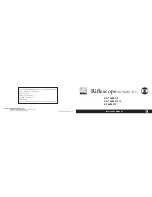
6
Observers in the Southern Hemisphere aren’t so fortunate to
have a bright star so near the south celestial pole (SCP). The
star Sigma Octantis lies about 1° from the SCP, but it is bare-
ly visible with the naked eye (magnitude 5.5). Consult a star
atlas or other reference book for instructions on polar-align-
ing your telescope in the Southern Hemisphere.
Polar Alignment
For general visual observation, an approximate polar alignment
is sufficient. This must be done at night, when Polaris is visible.
1. Level the equatorial mount by adjusting the length of the
three tripod legs accordingly.
2. Loosen the latitude lock T-bolt and turn the latitude adjus-
ment T-bolt to tilt the mount until the pointer on the latitude
scale is set at the latitude of your observing site. For
example, if your latitude is 40° North, set the pointer to 40.
Then retighten the latitude lock T-bolt. If you don’t know
your latitude, consult a geographical atlas to find it.
The latitude setting should not have to be adjusted again
unless you move to a different viewing location some dis-
tance away.
3. Loosen the Dec. lock knob and rotate the telescope opti-
cal tube until it is parallel with the R.A. axis. The pointer
on the Dec. setting circle should read 90°. Retighten the
Dec. lock knob.
4. Next, loosen the azimuth lock knob at the base of the
equatorial mount. Rotate the entire equatorial mount in
the horizontal direction until the R.A. axis points roughly at
Polaris. Retighten the lock knob.
The equatorial mount is now polar-aligned for casual observing.
More precise polar alignment is required for astrophotography.
Several methods exist and are described in many amateur
astronomy reference books and astronomy magazines.
Note that from this point on in your observing session, you
should not make any further adjustments in the azimuth or
the latitude of the mount, nor should you move the tripod.
Doing so will negate the polar alignment. The telescope
should only be moved about its R.A. and Dec. axes.
Tracking Celestial Objects
When you observe a celestial object through the telescope,
you’ll see it drift slowly across the field of view. To keep it in
the field, if your equatorial mount is polar-aligned, just turn the
R.A. slow-motion control. The Dec. slow-motion control is not
needed for tracking. Objects will appear to move faster at
higher magnifications, because the field of view is narrower.
An optional DC motor drive (Orion EQ-1M, #7826) can be
mounted on the R.A. axis of the Observer’s equatorial mount
to provide hands-free tracking. Objects will then remain sta-
tionary in the field of view without any manual adjustment of
the R.A. slow-motion control.
Note About the Declination Slow-Motion Control
The declination slow-motion control cable can only move the
telescope a maximum of 30°. This is because the mechanism
that the control cable attaches to will reach the end of its
mechanical “travel.” If, when using the Dec. slow-motion con-
trol, you can no longer rotate the control cable in a desired
direction, you have reached the end of travel, and the mech-
anism should be reset. This is done by first rotating the
control cable several turns in the opposite direction from
which it was originally being turned. Then, manually move the
telescope closer to the object you wish to observe (remember
to first loosen the Dec. lock thumbscrew). You should now be
able to use the slow-motion control again to fine adjust your
position.
Understanding the Setting Circles
The setting circles on an equatorial mount enable you to
locate celestial objects by their “celestial coordinates.” Every
object resides in a specific location on the “celestial sphere,”
denoted by two numbers: its right ascension (R.A.) and dec-
lination (Dec.). In the same way, every location on Earth can
be described by its longitude and latitude. R.A. is similar to
longitude on Earth, and Dec. is similar to latitude. The R.A.
and Dec. values for celestial objects can be found in any star
atlas or star catalog.
The R.A. setting circle is scaled in hours, from 1 through 24,
with small hash marks in between representing 10-minute
increments (there are 60 minutes in 1 hour of R.A.). The
upper set of numbers (farthest from the R.A. gear) apply to
viewing in the Northern Hemisphere, while the numbers
below them apply to viewing in the Southern Hemisphere.
The Dec. setting circle is scaled in degrees (there are 60 min-
utes in 1 degree of declination).
So, the coordinates for the Orion Nebula listed in a star atlas
will look like this:
R.A. 5h 35.4m Dec. –5° 27'
Figure 3. To find Polaris in the night sky, look north and find the Big
Dipper. Extend an imaginary line from the two “Pointer Stars” in the
bowl of the Big Dipper. Go about five times the distance between
those stars and you’ll reach Polaris, which lies within 1° of the
north celestial pole (NCP).
Big Dipper
(in Ursa Major)
Little Dipper
(in Ursa Minor)
Cassiopeia
N.C.P.
Pointer
Stars
Polaris





















